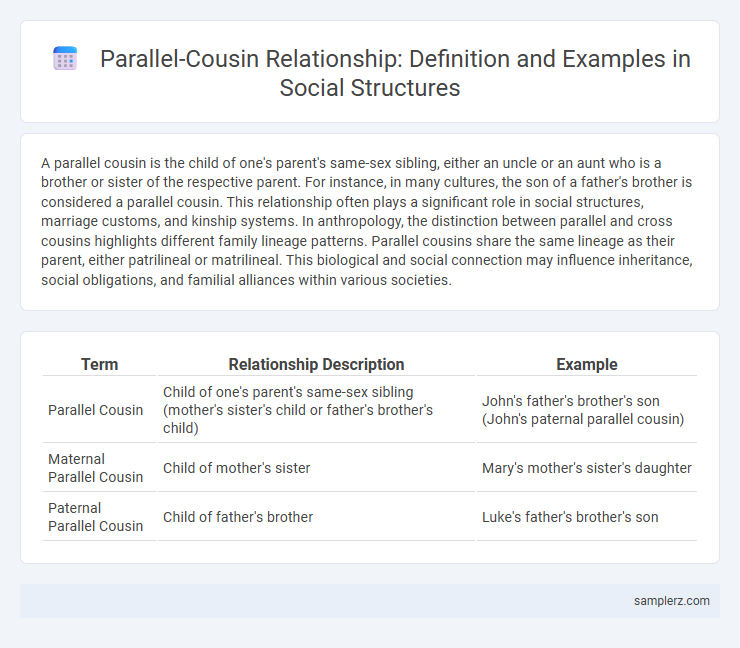A parallel cousin is the child of one's parent's same-sex sibling, either an uncle or an aunt who is a brother or sister of the respective parent. For instance, in many cultures, the son of a father's brother is considered a parallel cousin. This relationship often plays a significant role in social structures, marriage customs, and kinship systems. In anthropology, the distinction between parallel and cross cousins highlights different family lineage patterns. Parallel cousins share the same lineage as their parent, either patrilineal or matrilineal. This biological and social connection may influence inheritance, social obligations, and familial alliances within various societies.
Table of Comparison
| Term | Relationship Description | Example |
|---|---|---|
| Parallel Cousin | Child of one's parent's same-sex sibling (mother's sister's child or father's brother's child) | John's father's brother's son (John's paternal parallel cousin) |
| Maternal Parallel Cousin | Child of mother's sister | Mary's mother's sister's daughter |
| Paternal Parallel Cousin | Child of father's brother | Luke's father's brother's son |
Understanding Parallel Cousins in Social Relationships
Parallel cousins are the children of a parent's same-sex sibling, such as a father's brother's children or a mother's sister's children, and play a distinct role in various kinship systems worldwide. Understanding parallel cousins helps clarify family structures and marriage rules in many cultures, where parallel cousins are often considered close relatives with specific social obligations. This concept highlights the importance of lineage and descent in shaping social relationships and kinship patterns across societies.
Defining Parallel-Cousin Relationships: Key Concepts
Parallel cousins are the children of same-sex siblings, meaning the offspring of two brothers or two sisters. These relationships often carry distinct cultural significance, as parallel cousins may be considered as close as siblings and are sometimes preferred marriage partners in certain societies. Understanding the distinction between parallel and cross cousins is essential for analyzing kinship systems and social organization in anthropology.
Real-Life Examples of Parallel Cousins in Communities
In many Indigenous communities, parallel cousins play integral roles in social structure, often considered siblings and subject to similar kinship rules. Among the Navajo, parallel cousins are classified as siblings, fostering strong bonds that influence marriage choices and collective responsibilities. This kinship system maintains community cohesion by promoting alliances within specific family lines rather than between them.
Parallel Cousin Marriage: Social Perspectives
Parallel cousin marriage, involving the union between children of two siblings of the same gender, is a prevalent practice in various cultures, particularly in Middle Eastern and South Asian societies. This tradition is often valued for preserving family wealth, strengthening kinship ties, and maintaining social cohesion within tribal or clan-based communities. Social perspectives on parallel cousin marriage vary widely, with proponents emphasizing cultural continuity and critics raising concerns about genetic risks and individual autonomy.
Cultural Norms Surrounding Parallel Cousin Bonds
Parallel cousins, the children of two same-gender siblings, often engage in culturally significant relationships shaped by social norms in various societies. In many Middle Eastern and South Asian cultures, parallel cousin marriage is traditionally encouraged to strengthen family ties and preserve lineage. These cultural practices reflect deep-rooted values emphasizing kinship solidarity and communal cohesion.
Social Roles of Parallel Cousins in Family Structures
Parallel cousins, typically the children of two brothers or two sisters, often occupy unique social roles within family structures, serving as key figures in maintaining familial alliances and shared responsibilities. In many cultures, they are considered akin to siblings, with expectations of mutual support and cooperation that reinforce family cohesion and social stability. These parallel cousins frequently participate in joint activities, inheritance practices, and marital arrangements that underscore their integral position in the social fabric of the family.
Parallel Cousins vs Cross Cousins: Social Implications
Parallel cousins, the children of two siblings of the same gender (e.g., two brothers or two sisters), often face stricter social taboos against marriage in many cultures compared to cross cousins, who are the children of opposite-gender siblings (e.g., a brother and a sister). This distinction influences kinship structures and marriage rules, where unions with cross cousins may be encouraged to strengthen alliances between families, while parallel cousin marriages are frequently prohibited to maintain clear lineage boundaries. Understanding these social implications helps clarify the complex role of kinship and marriage taboos in shaping community cohesion and inheritance patterns.
Parallel Cousin Relationships in Global Cultures
Parallel cousin relationships vary widely across global cultures, often influencing marriage customs and kinship structures; for example, in many Middle Eastern and South Asian societies, marrying a parallel cousin, such as the child of a father's brother, is common and socially accepted to strengthen family ties and preserve wealth. In contrast, many Western cultures typically view parallel cousin marriage as taboo or legally restricted, emphasizing nuclear family boundaries instead. Anthropological studies show these differences reflect broader societal values regarding family, inheritance, and social cohesion.
Social Benefits and Challenges of Parallel Cousin Connections
Parallel cousins, the children of two siblings of the same sex, often experience strong social bonds due to shared family culture and close-knit upbringing, fostering support networks that enhance emotional well-being. These relationships can facilitate trust and cooperation within extended families, which benefits social cohesion and resource sharing. However, challenges include navigating community norms regarding marriage and potential genetic concerns, requiring balanced understanding within social dynamics.
Evolving Social Attitudes Toward Parallel Cousin Relationships
Parallel cousin relationships, where individuals marry the children of two same-sex siblings, have historically been viewed variably across cultures, with societies like the Hausa of Nigeria traditionally endorsing them to strengthen family ties. Recent shifts in evolving social attitudes highlight increased scrutiny due to genetic concerns and changing norms about marriage and kinship. Studies indicate a growing acceptance of diverse relationship structures while maintaining cultural distinctions regarding parallel cousin unions in social frameworks.

example of parallel-cousin in relationship Infographic
 samplerz.com
samplerz.com